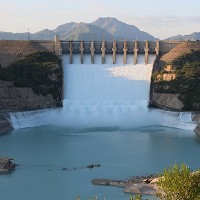20 July 2021
The Indus basin: untapped potential for long-term energy storage
According to the International Energy Agency (IEA), the growth of hydropower plants worldwide is set to slow down this decade. This puts at risk the ambitions of countries across the globe aiming to reach net-zero emissions while ensuring reliable and affordable energy supplies for their citizens. Even so, there are thousands of dams planned to be built this next decade. New hydropower dams installed worldwide are forecasted to increase global hydroelectricity capacity from the current 1,200 gigawatt (GW) to around 1,700 GW. Many of these dams are being built in countries with emerging economies, such as those in the Balkan region, Ethiopia, and Pakistan. Hydropower is very important in reaching net zero goals, not only because of its ability to produce clean energy, but also because of its capabilities in terms of energy storage. The Indus basin, which stretches across parts of Afghanistan, China, India, and Pakistan, is one area with huge hydropower potential due to its high altitudes and large water availability.
According to Pakistan’s State of Industry Report, 100% of Pakistan’s hydropower already comes from the Indus basin, and much of the region’s potential has yet to be tapped into. Additionally, an investigation into medium sized hydropower projects in Pakistan revealed that the Indus basin is the region with the largest and cheapest seasonal energy storage potential.
IIASA researchers explored the future of hydropower in the Indus region in a new paper published in the Journal of Energy Storage. They focused much of their research on the costs and benefits of hydropower, water storage, and long-term and short-term energy storage in the Indus Basin. They considered the potential and costs of conventional hydropower dams, as well as seasonal pumped hydropower storage. Unlike conventional dams, which are built in the cross sections of main rivers, seasonal pumped hydropower storage plants act as artificial reservoirs off the main river usually at higher altitudes with a built in power or pumping station that generates hydroelectric power or fills up the reservoir.
According to the researchers, many of the challenges faced in the Indus region regarding hydropower are due to larger water management issues. These issues stem from high population growth seen in the area coinciding with rapid urbanization, industrialization, environmental degradation, lack of water storage infrastructure, and outdated irrigation systems. The seasonality of the Indus region is something else the team had to consider. The Indus River deals with droughts in the winter and monsoon season, and melting snow and ice masses from the mountains in the summer. This considerably increases the flow of the river with many regular flooding events also occurring. Land changes from climate change and reduced groundwater levels further exacerbate flooding events and water scarcity.
To gather their data, the researchers used different models estimating power potentials as well as their corresponding costs. They incorporated five essential components: the physical features of the area, the river network and water flow data, infrastructure cost estimation, and project design optimization.
The researchers’ models and analysis concluded that the Indus region has the potential to play a similar role in energy storage for Asia as the Alps does in Europe.
“We found that the levelized energy storage cost in the Indus region is US $1 per megawatt hour (MWh) for conventional hydropower and $2/MWh for seasonal pumped storage, which is the lowest cost long-term energy storage alternative in the world. Even cheaper than natural gas reinjection in empty gas reservoirs, these low costs can justify the use of seasonal pumped hydropower storage to store energy in a yearly, two-year, or three-year energy cycle. The levelized costs of energy storage with batteries is around $100/MWh. This makes hydropower energy storage 100 times cheaper and seasonal pumped hydropower storage 50 times cheaper. For this reason, these are good solutions for long-term energy storage,” explains study lead-author Julian Hunt.
As more countries industrialize and develop their economies, growing energy demands are sure to follow. Having long-term energy storage using low emission methods like hydropower is important, especially during the era of climate change. The Indus basin can serve as a global supply.
”During the summer when there is high availability of water in the Indus basin, for example, excess solar power in northern hemisphere countries can be used to pump water in seasonal pumped hydropower storage plants in the basin, so that hydropower can be generated during the winter. With an integrated hydrogen and battery economy in the future, the region could serve as the world’s long-term energy storage hub,” Hunt concludes.
Reference
Hunt, J., Falchetta, J, Parkinson, S., Vinca, A., Zakeri, B., Byers, E., Jurasz, J., Quaranta, E., et al. (2021). Hydropower and seasonal pumped hydropower storage in the Indus basin: pros and cons. Journal of Energy Storage DOI: 10.1016/j.est.2021.102916

NEWS
"Climate Modernity" - The 24H Challenge: How do we want to live and act in the future in Styria ?
Health fears can increase pandemic isolation habits in older Europeans
How circular waste management systems can benefit the environment
Launch of the Northern African Applied Systems Analysis Centre
How we measure the effects of methane matters for climate policy


